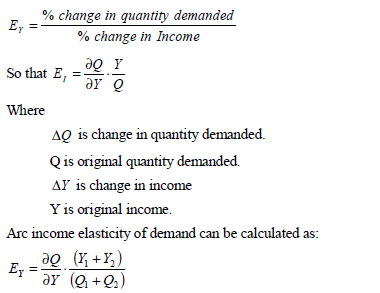1. Income Elasticity of Demand
This can be defined as the responsiveness of quantity demanded to change in income
In % term it can be defined as:

- Income elasticity of demand for most commodities is positive, indicating higher purchases at higher income. Income elasticity for a few commodities is known as inferior goods.
- Degree of income elasticity varies in accordance with the nature of commodities consumers consume in general. Where the commodity id a basic necessity, the demand is not very responsive to change in income. Basic necessities like food are usually bought in fairly constant amount and on regular basis. In this case E
y < 1
- However, in the case of luxuries, the demand is very responsive to change in income. Sales of such goods increase rapidly with increase in income. In this case E
y > 1
2. Cross elasticity of Demand
- The demand for one product can be influenced by the demand. For example, the demand for beef depends on the demand for pork, mutton and fish etc. if the price of beef rises while prices of substitutes (pork, mutton and fish) remains unchanged,
consumers will substitute beef with the cheaper product.
- In some cases, an increase in price of one product can lead to s reduction in demand for other products. This is true of complementary products e.g. electricity and electronic gadget, petrol to automobile etc. in this case the products are considered to be complementary or used together rather the substitutes.
- Therefore, cross elasticity is the percentage change in quantity demanded of good x due to 1 % change in the price of good Y it measures the degree of responsiveness of demand for one product to changes of the price of its substitutes or complementary
goods
- For instance, cross elasticity of demand for tea (T) is the percentage change in its quantity demanded with respect to one (1) percent change in price of its substitute coffee (C).

Cross elasticity of demand can either be positive or negative.
- A high positive cross elasticity means that the commodities are cross substitutes. If price of butter increases, the price of its substitutes (margarine) held constant, the quantity demanded of margarines would increase.
- A negative cross elasticity means that the goods are complementary in the market, thus a decrease in the price of one stimulates the sale of the other.
- A cross elasticity of zero means that the goods are independent of each other in the market.
Wilfykil answered the question on
March 6, 2019 at 08:18